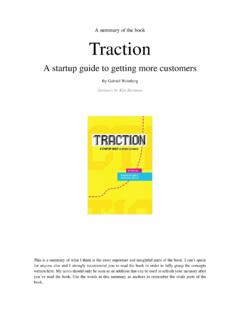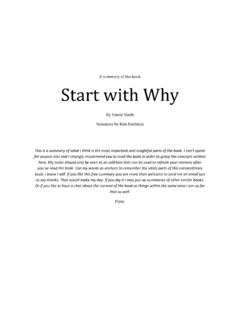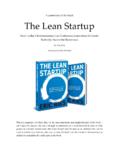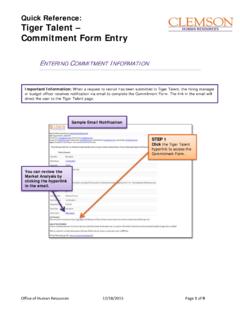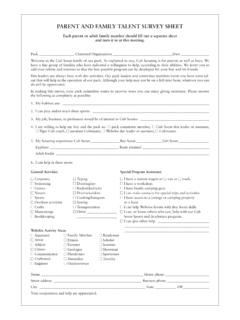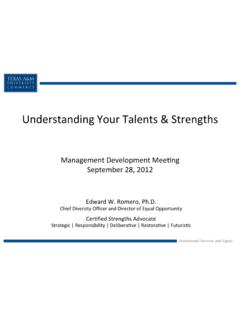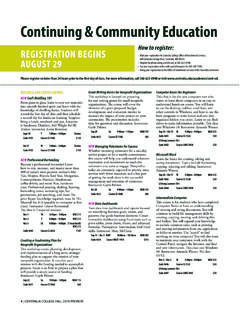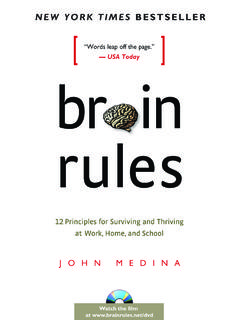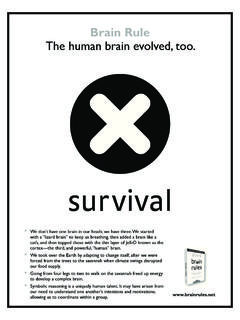Transcription of Bounce - Kim Hartman | Behavior Creativity Technology
1 A summary of the book Bounce The myth of talent and the power of practice By Matthew Syed Summary by Kim Hartman This is a summary of what I think is the most important and insightful parts of the book. I can't speak for anyone else and I strongly recommend you to read the book in order to grasp the concepts written here. My notes should only be seen as an addition that can be used to refresh your memory after you ve read the book. Use my words as anchors to remember the vitals parts of this extraordinary book. I know I will. Or you can just hire me and get the content of this book as well as many others in one, beautiful package. I m always up for a fun challenge, so bring it on. More book summaries at Contact me at Follow me on Twitter & Instagram @tjimm Contents Description from amazon .. 2. Chapter 1: The hidden logic of success .. 3. Chapter 2: Miraculous children? .. 5. Chapter 3: The path to excellence .. 6. Chapter 4: Mysterious sparks & life-changing mindsets.
2 9. Chapter 5: The placebo effect .. 11. Chapter 6: The curse of choking and how to avoid 12. Chapter 7: Baseball rituals, pigeons, and why great sportsmen feel miserable after 13. Chapter 8: Optical illusions and X-ray vision .. 14. Chapter 10: Are black's superior runners? .. 15. 1. More book summaries at Contact me at Follow me on Twitter & Instagram @tjimm Description from Amazon Essential reading following an astounding summer of sport; if you've ever wondered what makes a champion, Bounce has the answer. What are the real secrets of sporting success, and what lessons do they offer about life? Why doesn't Tiger Woods choke ? Why are the best figure skaters those that have fallen over the most and why has one small street in Reading produced more top table tennis players than the rest of the country put together. Two-time Olympian and sports writer and broadcaster Matthew Syed draws on the latest in neuroscience and psychology to uncover the secrets of our top athletes and introduces us to an extraordinary cast of characters, including the East German athlete who became a man, and her husband and the three Hungarian sisters who are all chess grandmasters.
3 Bounce is crammed with fascinating stories and statistics. Looking at controversial questions such as whether talent is more important than practice, drugs in sport (and life) and whether black people really are faster runners, the mind-bending Bounce is a must-read for the hardened sports nut or brand new convert. 2. More book summaries at Contact me at Follow me on Twitter & Instagram @tjimm Chapter 1: The hidden logic of success The delusion lies in focusing on the individuality of their triumph without perceiving or bothering to look for the powerful opportunities stacked in their favor. Ericson's experiment: purposeful practice was the only factor distinguishing the best from the rest. It is practice, not talent that ultimately matters. Experiment with British music students: hour for hour, the various groups had improved with almost identical rates. The difference was simply that top performers had practiced for more hours.
4 A minimum of ten years is required to reach world-class status in any complex task. Gladwell: most top performers practice for around 10 000 hours per year (it is difficult to sustain the quality of training if you go beyond that). An arbitrary difference in birth date sets in train a cascade of consequences that, within a matter of a few years, has created an unbridgeable chasm between those who, in the beginning, were equally well equipped for sporting stardom. The iceberg illusion by Ericsson: when we witness extraordinary feats of memory (or of sporting or artistic prowess) we are witnessing the end product of a process measured in years. What is invisible for us the submerged evidence, as it were is the countless hours of practice that have gone into the making of the virtuoso performance. Anybody can achieve the same results with opportunity and dedication. Retrieval structure: make sense of numbers and words and put them in a context.
5 3 4 9 2 can be thought of as 3 minutes and 49,2 seconds, a time for running a marathon. In a nutshell, when chess masters look at the positions of the pieces on a board, they see the equivalent of a word. Their long experience of playing chess enables them to chunk the pattern with a limited number of visual fixations in the same way that our familiarity with language enables us to chunk the letters constituting a familiar word. It is a skill derived from years of familiarity with the right language , not talent . (p. 24). It's not as simple as just knowing about where to look; it is also about grasping the meaning of what you are looking at. It is about looking at the subtle patterns of movement and postural clues and extracting information. Think about a tennis player that looks at the trunk and hips of their opponents on return in order to pick up the visual clues governing where they are going to serve. Recognition of familiar scenarios and the chunking of perceptual information into meaningful wholes and patterns speed up processes.
6 Speed in sport is not based on innate reaction speed but derived from highly specific practice. The limiting factor in making a world-class stroke isn't strength or brute force, but the executive control of fine motor movement to create perfect timing. 3. More book summaries at Contact me at Follow me on Twitter & Instagram @tjimm Federer has practiced for so long that the movement have been encoded in implicit rather than explicit memory. This is what psychologists call expert-induced amnesia. The most important differences are not at the lowest levels of cells or muscle groups, but at the athlete's superior control over the integrated and coordinated actions of their bodies. Expert performance is mediated by acquired mental representations that allow the experts to anticipate, plan and reason alternatives courses of action. ( ). It is practice, not talent that holds the key to success. Study on decision-making in the real world: The curious thing was not that top-decision makers like firefighters and doctors were making choices based on unexpected favors; it was that they did not seem to be making choices at all.
7 Expert firefighters are able to confront a burning building and almost instantly place it within the context of a rich, detailed, and elaborate conceptual scheme derived from years of experience. They can chunk the visual properties of the scene and comprehend its complex dynamics, often without understanding how. This is extrasensory perception, a sixth sense. What they all have in common is long experience and deep knowledge. Knowledge-free computing, however sophisticated, is impotent. The most important ingredient in an expert system is knowledge. Programs that are rich in general inference methods some of which may even have some of the power of mathematical logic but poor in domain-specific knowledge can behave expertly on almost no tasks. Expert knowledge simply cannot be taught in the classroom over the course of a rainy afternoon. Sure, you can offer pointers of what to look for and what to avoid, and these can be helpful.
8 But relating the entirety of the information is impossible because the cues being processed by experts . in sports or elsewhere are so subtle and relate to each other in such complex ways that it would take forever to codify them in their mind-boggling totality. This is known as combinatorial explosion. Good decision-making is about compressing the informational load by decoding the meaning of patterns derived from experience. This cannot be taught in a classroom; it must be lived and learned. It emerges through practice. Expertise is a long-term development process, resulting from rich instrumental experiences in the world and extensive practice. To be successful, a chess player must cut down on the computational load by ignoring moves unlikely to result in a favorable outcome and concentrating on those with greater promise. Kasparov is able to do this by understanding the meaning of game situations. Deep Blue (the chess computer) is not.
9 An example of circumventing explosion via advanced pattern recognition: Gretzky can discern the games underlying pattern and flow, and anticipate what's going to happen faster than anyone else in the building. Several times during game you'll see hi making what seem to be aimless circles on the other side of the rink from the traffic, and then, as if answering a signal, hell dart ahead to a spot where, an instant later, the puck turns up. 4. More book summaries at Contact me at Follow me on Twitter & Instagram @tjimm Chapter 2: Miraculous children? Child prodigies amaze us because we compare them not with other performers who have practiced for the same length of time, but with children of the same age who have not dedicated their lives in the same way. Extensive research has shown that there is a scarcely a single top performer in any complex task who has circumvented the ten years of hard work necessary to reach the top.
10 A young performer has a sizeable head start on anybody who commences their training a few years later. It is only possible to clock u meaningful practice if an individual has made an independent decision to devote himself to whatever field of expertise. He has to care about what he is doing, not because a parent or a teacher says so, but for its own sake. This is called internal motivation. The only circumstances in which very early development seem to work is where the children themselves are motivated to clock up the hours, rather than doing so because of parents or a coach. The key is to be sensitive to the way the child is thinking and feeling, encouraging training without exerting undue pressure. The dangers of starting out to hard, too young, often outweigh the benefits. One of the skills of a good coach is to tailor a training program to the mindset of the individual. Onlookers took the performance to be the consequence of special abilities because they had witnessed only a tiny percentage of the activity that had gone into its making.
